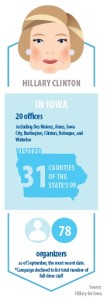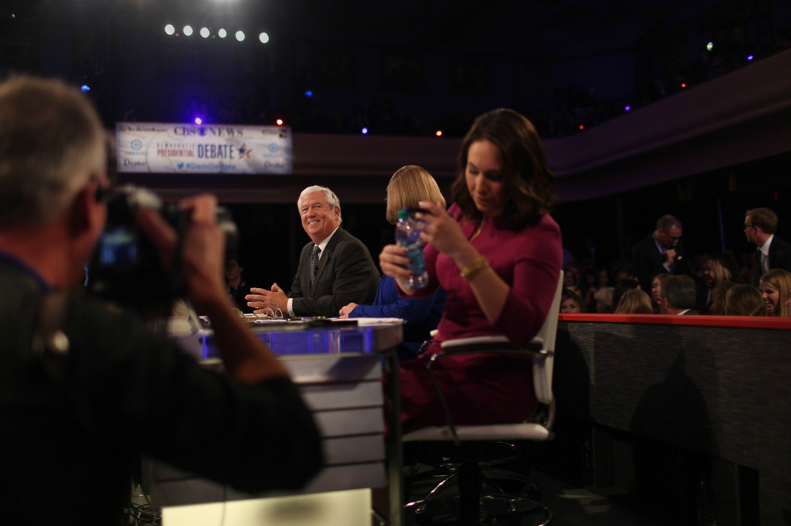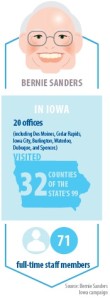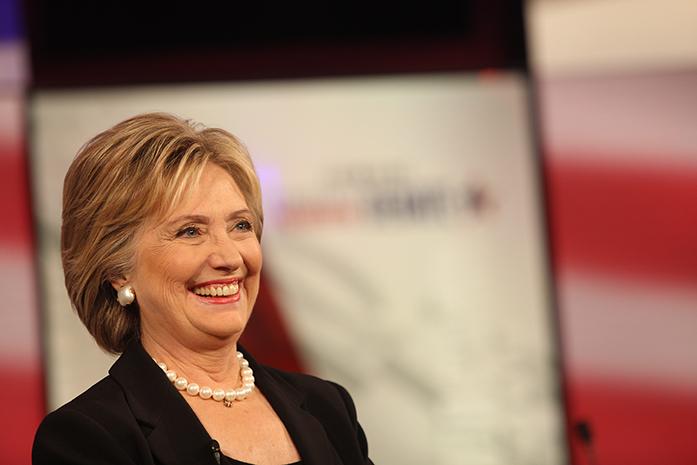Hillary Clinton’s cash-rich political army continues to dominate Iowa’s Democratic landscape by the sheer number of lucrative endorsements, full-time staff and organizing offices.Iowa’s largest public employee union, AFSCME Iowa Council 61, publicly threw its support behind the former Secretary of State Tuesday, aligning 40,000-plus firefighters, mental health workers, professional school staff and others with the establishment Democrat.
Iowa’s “favorite son,” former Sen. Tom Harkin, D-Iowa, and his wife, Ruth, loyally came to her side back in August.
RELATED: King tries to boost Cruz control
With 78 dedicated organizers on the ground here, Clinton crushes former Maryland governor Martin O’Malley, who has 37 full-time staffers. She has 7 more full-time operatives as her closest rival, Vermont Sen. Bernie Sanders, according to a review of campaign records.
But does a candidate with the most brick and mortar offices and staffers really matter to Iowa’s well-educated Democratic caucus-going electorate? And is there a “sweet spot” or threshold of success?
The Daily Iowan surveyed a handful of long-time and newcomer Iowa political strategists to find out, 76 days before the Iowa caucuses.
Trading political enthusiasm for staffers
“Obviously the more campaign staff you have here and more resources you have, the more voter contact you will have and that is pivotal in winning the caucuses,” said Gayle Alberda, a visiting professor of political science at Drake University.
 Each cycle, Democrats meet in one of the 1,682 precincts (think school, public buildings and homes) to elect caucus delegates.
Each cycle, Democrats meet in one of the 1,682 precincts (think school, public buildings and homes) to elect caucus delegates.
Because Clinton has legions of door-knockers, phone bankers and clipboard-wielding supporters, she is best armed to secure precinct votes, experts said.
Alberda formerly worked on the John McCain-Sarah Palin 2008 presidential campaign, among a number of other state and national political operations. Even with the rise of Facebook, Snapchat and other digital verticals, she predicted physical bodies on the ground won’t become less important in future presidential cycles beyond 2016.
RELATED: UI law professor gets national moment at Democratic presidential debate
Alberda and other analysts interviewed threw caution to the wind.
An underdog such as O’Malley, who is running a lean Iowa operation of fewer than 40 full-time staffers and hundreds of voluntary organizers could do “more with less,” she said.
By staffing up in large numbers, Clinton could lose the critical face-to-face interaction with voters behind each door.
“You basically trade off enthusiasm for staffers and there’s certainly something that Clinton is doing,” warned Tim Hagle, a University of Iowa associate professor of political science.
• Scroll through our latest political photo slideshows
Hagle keeps regular tabs on the movings and shakings of Iowa politics, particularly the GOP and has advised the UI College Republicans.
He said Clinton could see this repeat problem she faced in the 2008 election: deploying out-of-touch loyalists who see Iowa Democrats as part of a numbers game instead of getting to individual Democratic organizer.
Location, location, location
Eight years ago, then-Sen. Barack Obama, D-Ill., didn’t just roll out a data-driven voter initiative. To lock up the caucuses, he sought out rural Iowa. A few precincts here, a few there.
“He can still go into an Iowa living room and it’s not logistically impossible to do” — Christopher Larimer, associate professor of political science, University of Northern Iowa said of Martin O’Malley
In 2011, to the dismay of some Iowa Democrats, he and his staff worked to entice evangelical voters. The conservative base historically aligns with Republicans.
That year, Obama lured some evangelicals away from Newt Gingrich’s Republican presidential bid.
RELATED: Bobby Jindal suspends presidential campaign
Democratic caucus-goers tend to live in Iowa’s urban centers, according to Iowa Secretary of State records.
Aside from Des Moines and Iowa City, (which this caucus campaign cycle has become known as Bernie Sanders country), Davenport and Bettendorf, Cedar Rapids and Cedar Falls are key.

Each city has strong Democratic Party registrations.
“For Hillary Clinton, putting an office in Iowa City, where it is Sanders’ territory, it appears that she is trying to go after him,” said Alberda. “If you’re the Bernie campaign, you get nervous. It’s about the chess pieces.”
Can Sanders be significant?
Sanders, a New England independent running as a Democrat for the presidential nomination, has had no trouble bringing out loud crowds in Iowa.
College students at the UI, Iowa State University, University of Northern Iowa and Grinnell College serve as his primary foot soldiers. On a daily basis they are tasked with whipping together more young people to fill out “commit-to-caucus” postcards.
RELATED: Democrats look at who’s ‘unelectable’
He, like Clinton, has multiple TV ad buys in Iowa. Seventy-one full-time staffers are stationed in Iowa, regularly visiting the campaign’s 20 organizing offices.
Among those in his political corner are Johnson County Supervisor Mike Carberry and Blair Lawton. Both have said they support Sanders for his alternative energy policies and rampant opposition to Wall Street mega banks.
“Obviously the more campaign staff you have here and more resources you have, the more voter contact you will have and that is pivotal in winning the caucuses” — Gayle Alberda, visiting professor of political science, Drake University, said of the Iowa caucuses
Carberry serves as director of the influential Iowa Wind Energy Association, a Milford-based non-profit corporation that works to grow the state’s wind energy industry. The group represents over 180 state and national members, including several UI colleges and Mid American Energy.
 A few months ago, Lawton was all in for Sen. Elizabeth Warren, D-Mass., serving as the Iowa field director for Run Warren Run. Warren, a far-left liberal, was being pushed by the draft group to launch a presidential bid of her.
A few months ago, Lawton was all in for Sen. Elizabeth Warren, D-Mass., serving as the Iowa field director for Run Warren Run. Warren, a far-left liberal, was being pushed by the draft group to launch a presidential bid of her.
As of Tuesday, Sanders has visited just 32 of Iowa’s 99 counties in Iowa, as of Tuesday. Some insiders and analysts have warned that he may not be able to visit all 99 in the fewer than 80 days before the Iowa caucuses.
RELATED: Hillary Clinton: Gun control should be a ‘voting issue’ for Democrats
Others, including Sen. Tony Bisignano, D-Des Moines, who had been working for months trying to persuade Vice President Joe Biden to pursue a third presidential run, see Sanders and unelectable.
Iowa strategists who spoke with the DI following the Nov. 14 Democratic presidential debate said they have new worries that Sanders and his staff won’t be able to navigate foreign policy agendas after he presented an unclear viewpoint on international relations.
Some political observers like Christopher Larimer, an associate professor of political science at the University of Northern Iowa, say Sanders’s rising political street cred in Iowa have made him less approachable.
Hope for O’Malley?
More Iowans are giving O’Malley a second look, discussions with Democrats after the recent debate show. The Marylander picked up 28 more Iowa endorsements Monday, including Polk County Democrats chairman Tom Henderson, two local school board officials and a candidate for the Iowa House of Representatives.
 The latest round of endorsements came within hours of major staff changes at O’Malley’s campaign headquarters in Baltimore.
The latest round of endorsements came within hours of major staff changes at O’Malley’s campaign headquarters in Baltimore.
O’Malley spokeswoman Haley Morris told the DI that the campaign’s headquarters is being scaled back to focus on ground game efforts in Iowa and New Hampshire.
RELATED: O’Malley sees ‘breakout’ performance at Democratic debate, Iowa political observers say
Morris said all staffers currently working in Baltimore will be given the option to transition to positions in Iowa and New Hampshire.
Thirty-seven full-time staffers make up O’Malley’s Iowa roster. He has visited 47 counties and has offices in Des Moines, Cedar Rapids and Sioux City. Additional offices are being sought in Iowa City and other areas of the state, according to aides.
Fewer people to manage and explain the campaign’s central themes help keep O’Malley light on his feet when he’s traveling from county to county, Alberda and other strategists noted.
“He can still go into an Iowa living room and it’s not logistically impossible to do,” Larimer, the UNI professor, said of O’Malley.



